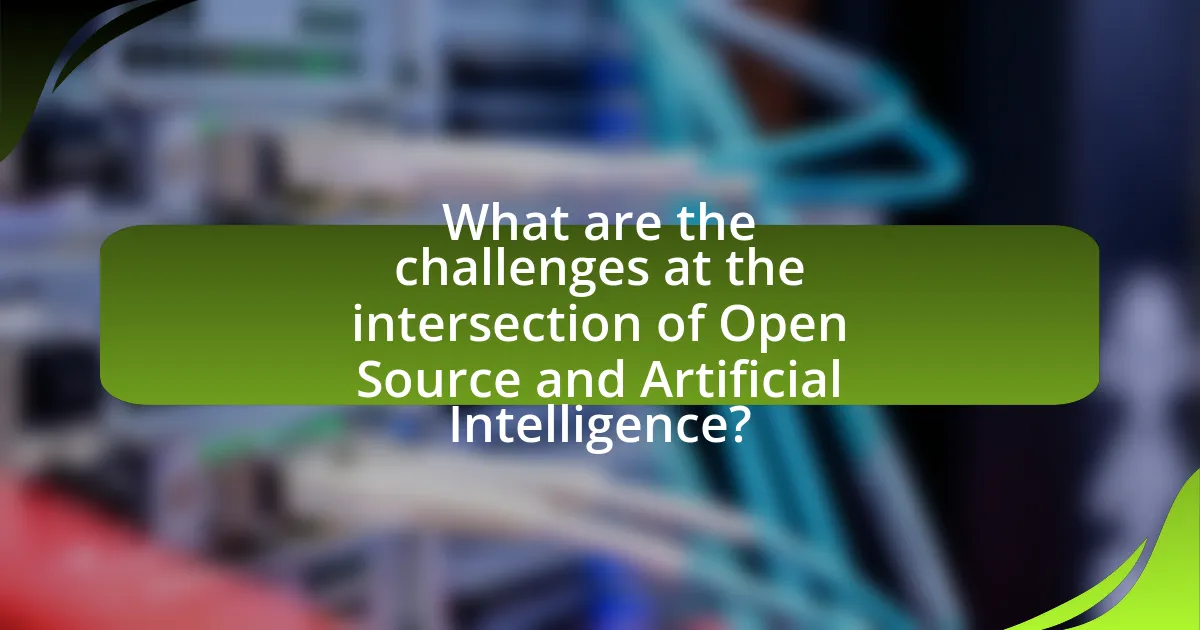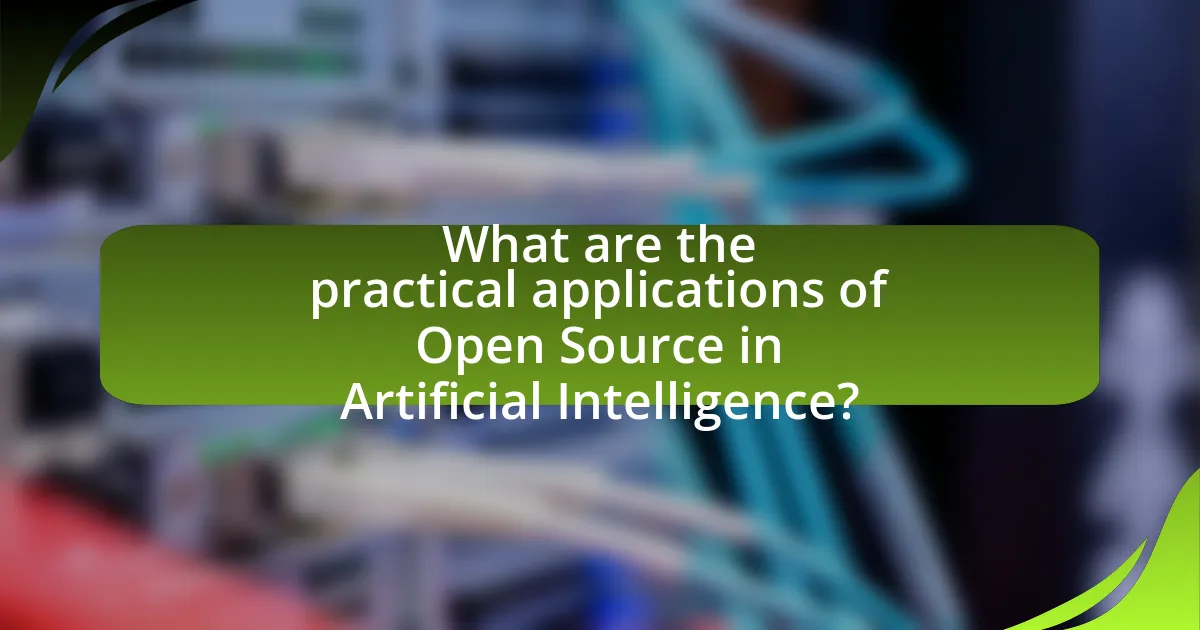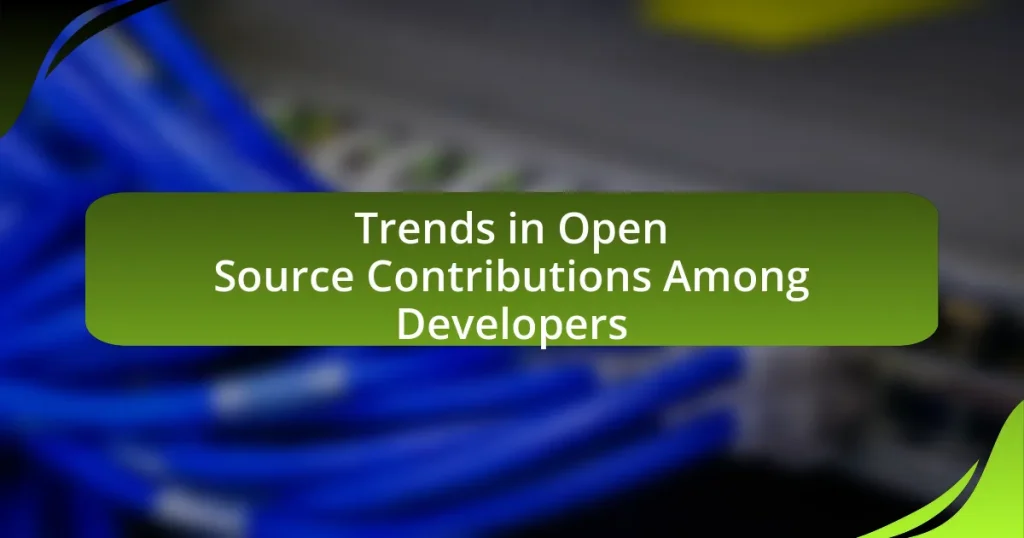The article explores the intersection of open source and artificial intelligence, emphasizing the collaborative development and accessibility of AI technologies through open source frameworks like TensorFlow and PyTorch. It discusses how open source principles promote transparency, innovation, and ethical practices in AI development, while also addressing challenges such as intellectual property, quality control, and bias. Key characteristics of open source software in AI, its role in democratizing access, and the implications of licensing issues are examined, alongside practical applications and notable projects in various industries. The article concludes with best practices for organizations to effectively implement open source AI solutions and resources available for learning about this evolving field.

What is the Intersection of Open Source and Artificial Intelligence?
The intersection of open source and artificial intelligence lies in the collaborative development and accessibility of AI technologies. Open source frameworks, such as TensorFlow and PyTorch, enable developers to share code, improve algorithms, and foster innovation in AI applications. This collaborative environment accelerates advancements in machine learning and deep learning, as evidenced by the rapid growth of open source AI projects, which have contributed to significant breakthroughs in natural language processing and computer vision. The availability of open source tools allows researchers and practitioners to build upon existing work, leading to more robust and diverse AI solutions.
How do open source principles apply to artificial intelligence?
Open source principles apply to artificial intelligence by promoting collaboration, transparency, and accessibility in AI development. These principles enable developers to share code, datasets, and algorithms, fostering innovation and accelerating advancements in the field. For instance, projects like TensorFlow and PyTorch exemplify open source AI frameworks that allow researchers and developers to build upon existing work, leading to improved models and applications. The availability of open datasets, such as ImageNet, further supports the training of AI systems, enhancing their performance and reliability. This collaborative environment not only democratizes access to AI technology but also encourages ethical practices and community-driven improvements.
What are the key characteristics of open source software in AI?
Open source software in AI is characterized by its accessibility, collaborative development, transparency, and community-driven support. Accessibility allows users to freely use, modify, and distribute the software, fostering innovation and experimentation. Collaborative development involves contributions from a diverse range of developers, enhancing the software’s capabilities and addressing various use cases. Transparency ensures that the underlying algorithms and data can be examined and audited, promoting trust and ethical use. Community-driven support provides users with resources, forums, and documentation, facilitating knowledge sharing and problem-solving. These characteristics collectively contribute to the rapid advancement and democratization of AI technologies.
How does open source foster collaboration in AI development?
Open source fosters collaboration in AI development by providing accessible code and resources that enable developers to contribute, modify, and share their work. This collaborative environment accelerates innovation, as diverse teams can build upon each other’s contributions, leading to rapid advancements in AI technologies. For instance, projects like TensorFlow and PyTorch have large communities that actively collaborate, resulting in continuous improvements and shared knowledge, which enhances the overall quality and functionality of AI tools.
Why is the intersection important for technology advancement?
The intersection of open source and artificial intelligence is crucial for technology advancement because it fosters collaboration, accelerates innovation, and democratizes access to cutting-edge tools. Open source projects allow developers and researchers to share code, ideas, and resources, leading to rapid improvements and diverse applications in AI. For instance, the development of TensorFlow, an open-source machine learning framework by Google, has significantly advanced AI research and applications by enabling a wide range of contributors to enhance its capabilities. This collaborative environment not only speeds up technological progress but also ensures that advancements are accessible to a broader audience, promoting inclusivity and diverse contributions in the field.
What role does open source play in democratizing AI access?
Open source plays a crucial role in democratizing AI access by providing free and transparent resources that enable individuals and organizations to develop, modify, and deploy AI technologies. This accessibility fosters innovation and collaboration, allowing a diverse range of contributors to enhance AI capabilities without the barriers of proprietary software costs or restrictions. For instance, projects like TensorFlow and PyTorch have empowered thousands of developers worldwide to create AI applications, leading to a broader distribution of knowledge and tools. According to a 2021 report by the Open Source Initiative, open source software accounted for over 90% of AI research publications, highlighting its significance in advancing the field and making AI more inclusive.
How does open source contribute to innovation in AI?
Open source contributes to innovation in AI by enabling collaborative development and rapid iteration of algorithms and models. This collaborative environment allows researchers and developers to share code, datasets, and findings, accelerating advancements in AI technologies. For instance, projects like TensorFlow and PyTorch have become foundational frameworks in AI research, facilitating experimentation and deployment of machine learning models. The availability of these tools has led to significant breakthroughs, such as improvements in natural language processing and computer vision, evidenced by the widespread adoption of models like BERT and GPT. Furthermore, open source fosters transparency and reproducibility, which are critical for validating AI research and ensuring ethical practices in AI development.

What are the challenges at the intersection of Open Source and Artificial Intelligence?
The challenges at the intersection of Open Source and Artificial Intelligence include issues of intellectual property, quality control, and ethical considerations. Intellectual property concerns arise as open-source AI projects may inadvertently infringe on proprietary algorithms or datasets, leading to legal disputes. Quality control is a significant challenge, as the collaborative nature of open-source projects can result in inconsistent code quality and varying levels of expertise among contributors, potentially affecting the reliability of AI models. Ethical considerations also pose challenges, particularly regarding bias in AI algorithms, as open-source datasets may reflect societal biases, leading to unfair outcomes in AI applications. These challenges necessitate careful management and governance to ensure the responsible development and deployment of AI technologies within the open-source framework.
What ethical considerations arise from open source AI projects?
Open source AI projects raise several ethical considerations, primarily concerning accountability, bias, and misuse. Accountability is crucial because the decentralized nature of open source can lead to ambiguity regarding who is responsible for the outcomes of AI systems. For instance, if an open source AI tool is used to perpetuate harm, it may be unclear who should be held liable. Bias is another significant concern, as open source datasets may reflect societal prejudices, leading to discriminatory outcomes in AI applications. Research indicates that AI systems trained on biased data can reinforce existing inequalities, as seen in facial recognition technologies that misidentify individuals from certain demographic groups. Lastly, the potential for misuse of open source AI tools poses ethical dilemmas; malicious actors could exploit these technologies for harmful purposes, such as creating deepfakes or automating cyberattacks. These considerations highlight the need for ethical guidelines and frameworks to govern the development and deployment of open source AI projects.
How can bias in AI models be addressed through open source?
Bias in AI models can be addressed through open source by enabling collaborative development and transparency in algorithms and datasets. Open source platforms allow diverse contributors to identify and rectify biases by reviewing code and data, fostering a community-driven approach to improving model fairness. For instance, projects like TensorFlow and PyTorch provide tools for developers to share their findings and methodologies, which can lead to the identification of biased training data or flawed algorithms. Additionally, open datasets, such as those from the UCI Machine Learning Repository, allow researchers to benchmark models against a variety of demographic groups, ensuring that AI systems perform equitably across different populations. This collaborative effort not only enhances accountability but also accelerates the discovery of best practices for bias mitigation in AI.
What are the implications of data privacy in open source AI?
Data privacy in open source AI has significant implications, primarily concerning the handling and protection of sensitive data used in training models. Open source AI projects often rely on publicly available datasets, which can inadvertently expose personal information if not properly anonymized. For instance, the Cambridge Analytica scandal highlighted how data misuse can occur when privacy measures are inadequate, leading to unauthorized access and exploitation of personal data. Furthermore, the transparency of open source code allows for scrutiny, but it also means that vulnerabilities can be identified and exploited by malicious actors. Therefore, robust data governance practices and compliance with regulations like GDPR are essential to mitigate risks associated with data privacy in open source AI.
How do licensing issues affect open source AI development?
Licensing issues significantly impact open source AI development by determining how AI models and code can be used, modified, and distributed. Different licenses, such as the GNU General Public License (GPL) or the MIT License, impose varying restrictions and obligations on developers, which can influence collaboration and innovation. For instance, the GPL requires derivative works to also be open source, potentially discouraging commercial use, while the MIT License allows for more flexibility, encouraging broader adoption. This variation in licensing can lead to fragmentation in the AI community, as developers may choose different licenses based on their goals, which can complicate integration and interoperability of AI systems.
What are the common licenses used in open source AI projects?
Common licenses used in open source AI projects include the MIT License, Apache License 2.0, and GNU General Public License (GPL). The MIT License is favored for its permissiveness, allowing for reuse with minimal restrictions. The Apache License 2.0 provides an explicit grant of patent rights from contributors to users, which is significant in the AI field where patents can be contentious. The GNU GPL, particularly its version 3, emphasizes copyleft, requiring derivative works to also be open source, thus promoting software freedom. These licenses are widely adopted due to their clarity and the legal protections they offer to developers and users in the rapidly evolving AI landscape.
How do licensing choices impact collaboration and usage?
Licensing choices significantly impact collaboration and usage by defining the permissions and restrictions associated with software or content. For instance, permissive licenses like MIT or Apache encourage collaboration by allowing users to modify and redistribute the software with minimal restrictions, fostering a broader community engagement. In contrast, copyleft licenses, such as the GNU General Public License, require derivative works to be distributed under the same license, which can limit usage in proprietary contexts but ensures that improvements remain open and accessible. Research indicates that projects with permissive licenses tend to attract more contributors and have higher adoption rates, as seen in the popularity of libraries like TensorFlow, which is licensed under the Apache License 2.0. Thus, the choice of license directly influences the level of collaboration and the scope of usage within the open-source ecosystem, particularly in the field of artificial intelligence.

What are the practical applications of Open Source in Artificial Intelligence?
Open Source has several practical applications in Artificial Intelligence, including collaborative model development, accessibility of AI tools, and community-driven innovation. Collaborative model development allows researchers and developers to share algorithms and datasets, enhancing the speed and quality of AI advancements. For instance, TensorFlow and PyTorch, both open-source frameworks, enable developers to build and deploy machine learning models efficiently. Accessibility of AI tools democratizes technology, allowing startups and individuals to leverage sophisticated AI capabilities without significant financial investment. Additionally, community-driven innovation fosters rapid improvements and diverse applications, as seen in projects like Hugging Face’s Transformers, which provides pre-trained models for natural language processing tasks. These applications demonstrate how Open Source contributes to the growth and evolution of AI technologies.
What are some notable open source AI projects?
Notable open source AI projects include TensorFlow, PyTorch, and Apache MXNet. TensorFlow, developed by Google, is widely used for machine learning and deep learning applications, providing a flexible ecosystem for building and deploying models. PyTorch, created by Facebook, is favored for its dynamic computation graph and ease of use, making it popular among researchers and developers. Apache MXNet, supported by Amazon, is known for its scalability and efficiency in training deep learning models. These projects are significant in the AI community due to their extensive documentation, active user communities, and contributions to advancing AI research and applications.
How do these projects demonstrate the benefits of open source?
These projects demonstrate the benefits of open source by fostering collaboration, innovation, and transparency in artificial intelligence development. Open source allows developers from diverse backgrounds to contribute, leading to rapid advancements and improvements in AI technologies. For instance, projects like TensorFlow and PyTorch have gained widespread adoption due to their open access, enabling researchers and practitioners to build upon existing work, share findings, and enhance algorithms collectively. This collaborative environment accelerates problem-solving and reduces redundancy, as evidenced by the extensive community support and contributions that have resulted in more robust and versatile AI tools.
What industries are leveraging open source AI solutions?
Various industries are leveraging open source AI solutions, including technology, healthcare, finance, and education. The technology sector utilizes open source AI for software development and data analysis, with companies like Google and Facebook contributing to projects such as TensorFlow and PyTorch. In healthcare, organizations employ open source AI for medical imaging and predictive analytics, enhancing patient care and operational efficiency. The finance industry adopts these solutions for fraud detection and algorithmic trading, with firms using platforms like Apache Spark for data processing. Education benefits from open source AI through personalized learning tools and administrative automation, exemplified by projects like Open edX. These industries demonstrate the versatility and impact of open source AI across diverse applications.
How can organizations effectively implement open source AI?
Organizations can effectively implement open source AI by establishing a clear strategy that includes selecting appropriate open source frameworks, fostering a collaborative culture, and ensuring robust governance. Selecting frameworks like TensorFlow or PyTorch allows organizations to leverage existing community support and resources, which can accelerate development. Fostering a collaborative culture encourages knowledge sharing and innovation among team members, enhancing the overall effectiveness of AI projects. Additionally, implementing governance structures ensures compliance with licensing and ethical standards, which is crucial for maintaining the integrity of AI applications. According to a 2021 report by the Open Source Initiative, organizations that adopt open source solutions can reduce costs by up to 30% while increasing flexibility and scalability in their AI initiatives.
What best practices should be followed for successful integration?
Successful integration of open source and artificial intelligence requires clear communication, thorough documentation, and collaborative development practices. Clear communication ensures that all stakeholders understand project goals and requirements, which is essential for aligning efforts and minimizing misunderstandings. Thorough documentation provides a reference for developers and users, facilitating easier onboarding and maintenance. Collaborative development practices, such as using version control systems and encouraging contributions from diverse teams, enhance innovation and problem-solving. These practices are supported by studies indicating that well-documented projects with active community engagement tend to have higher success rates in software development.
How can teams ensure compliance with open source licenses?
Teams can ensure compliance with open source licenses by implementing a robust compliance program that includes thorough documentation, regular audits, and training for all team members. This program should involve maintaining an inventory of all open source components used in projects, ensuring that the licenses of these components are understood and adhered to, and integrating compliance checks into the development workflow. According to a 2021 report by the Open Source Security Foundation, organizations that actively manage open source compliance reduce the risk of legal issues and enhance software security.
What resources are available for learning about Open Source and AI?
Numerous resources are available for learning about Open Source and AI, including online courses, documentation, and community forums. Platforms like Coursera and edX offer courses specifically focused on Open Source software development and AI applications, often created by reputable institutions such as Stanford University and MIT. Additionally, the OpenAI website provides extensive documentation and tutorials on using their models, while GitHub hosts a plethora of open-source AI projects that can be explored and contributed to. Community forums like Stack Overflow and Reddit’s r/MachineLearning serve as valuable platforms for discussion and troubleshooting, further enhancing the learning experience.
Where can developers find open source AI tools and libraries?
Developers can find open source AI tools and libraries on platforms such as GitHub, GitLab, and Bitbucket. These platforms host a vast array of repositories containing AI frameworks like TensorFlow, PyTorch, and Scikit-learn, which are widely used in the AI community. GitHub alone has over 100 million repositories, many of which are dedicated to AI projects, making it a primary resource for developers seeking open source solutions. Additionally, websites like Open Source AI and Awesome AI provide curated lists of open source AI tools and libraries, further facilitating access to these resources.
What online communities support open source AI initiatives?
Online communities that support open source AI initiatives include GitHub, which hosts numerous repositories for collaborative AI projects, and Reddit, where subreddits like r/MachineLearning and r/OpenAI facilitate discussions and resource sharing. Additionally, forums such as AI Stack Exchange provide a platform for questions and knowledge exchange among AI practitioners. These communities foster collaboration, knowledge sharing, and development of open source AI tools and frameworks, contributing significantly to the advancement of the field.



